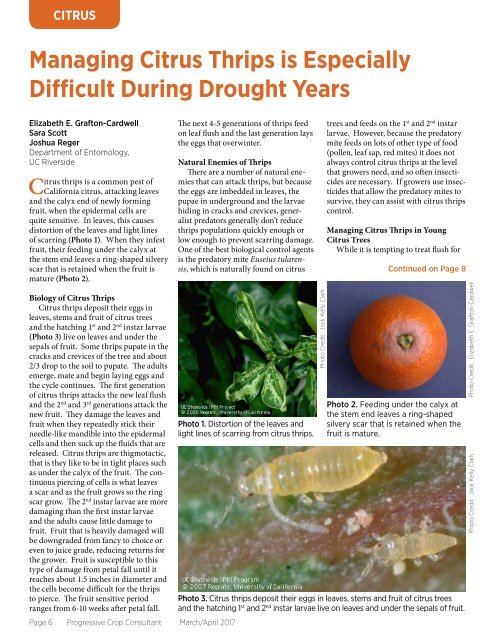Mar_Apr_PCC_2017_Web
Create successful ePaper yourself
Turn your PDF publications into a flip-book with our unique Google optimized e-Paper software.
CITRUS<br />
Managing Citrus Thrips is Especially<br />
Difficult During Drought Years<br />
Elizabeth E. Grafton-Cardwell<br />
Sara Scott<br />
Joshua Reger<br />
Department of Entomology,<br />
UC Riverside<br />
Citrus thrips is a common pest of<br />
California citrus, attacking leaves<br />
and the calyx end of newly forming<br />
fruit, when the epidermal cells are<br />
quite sensitive. In leaves, this causes<br />
distortion of the leaves and light lines<br />
of scarring (Photo 1). When they infest<br />
fruit, their feeding under the calyx at<br />
the stem end leaves a ring-shaped silvery<br />
scar that is retained when the fruit is<br />
mature (Photo 2).<br />
Biology of Citrus Thrips<br />
Citrus thrips deposit their eggs in<br />
leaves, stems and fruit of citrus trees<br />
and the hatching 1 st and 2 nd instar larvae<br />
(Photo 3) live on leaves and under the<br />
sepals of fruit. Some thrips pupate in the<br />
cracks and crevices of the tree and about<br />
2/3 drop to the soil to pupate. The adults<br />
emerge, mate and begin laying eggs and<br />
the cycle continues. The first generation<br />
of citrus thrips attacks the new leaf flush<br />
and the 2 nd and 3 rd generations attack the<br />
new fruit. They damage the leaves and<br />
fruit when they repeatedly stick their<br />
needle-like mandible into the epidermal<br />
cells and then suck up the fluids that are<br />
released. Citrus thrips are thigmotactic,<br />
that is they like to be in tight places such<br />
as under the calyx of the fruit. The continuous<br />
piercing of cells is what leaves<br />
a scar and as the fruit grows so the ring<br />
scar grow. The 2 nd instar larvae are more<br />
damaging than the first instar larvae<br />
and the adults cause little damage to<br />
fruit. Fruit that is heavily damaged will<br />
be downgraded from fancy to choice or<br />
even to juice grade, reducing returns for<br />
the grower. Fruit is susceptible to this<br />
type of damage from petal fall until it<br />
reaches about 1.5 inches in diameter and<br />
the cells become difficult for the thrips<br />
to pierce. The fruit sensitive period<br />
ranges from 6-10 weeks after petal fall.<br />
Page 6 Progressive Crop Consultant <strong>Mar</strong>ch/<strong>Apr</strong>il <strong>2017</strong><br />
The next 4-5 generations of thrips feed<br />
on leaf flush and the last generation lays<br />
the eggs that overwinter.<br />
Natural Enemies of Thrips<br />
There are a number of natural enemies<br />
that can attack thrips, but because<br />
the eggs are imbedded in leaves, the<br />
pupae in underground and the larvae<br />
hiding in cracks and crevices, generalist<br />
predators generally don’t reduce<br />
thrips populations quickly enough or<br />
low enough to prevent scarring damage.<br />
One of the best biological control agents<br />
is the predatory mite Euseius tularensis,<br />
which is naturally found on citrus<br />
Photo 1. Distortion of the leaves and<br />
light lines of scarring from citrus thrips.<br />
Photo Credit: Jack Kelly Clark<br />
trees and feeds on the 1 st and 2 nd instar<br />
larvae. However, because the predatory<br />
mite feeds on lots of other type of food<br />
(pollen, leaf sap, red mites) it does not<br />
always control citrus thrips at the level<br />
that growers need, and so often insecticides<br />
are necessary. If growers use insecticides<br />
that allow the predatory mites to<br />
survive, they can assist with citrus thrips<br />
control.<br />
Managing Citrus Thrips in Young<br />
Citrus Trees<br />
While it is tempting to treat flush for<br />
Continued on Page 8<br />
Photo 2. Feeding under the calyx at<br />
the stem end leaves a ring-shaped<br />
silvery scar that is retained when the<br />
fruit is mature.<br />
Photo 3. Citrus thrips deposit their eggs in leaves, stems and fruit of citrus trees<br />
and the hatching 1 st and 2 nd instar larvae live on leaves and under the sepals of fruit.<br />
Photo Credit: Jack Kelly Clark Photo Credit: Elizabeth E. Grafton-Cardwell


















